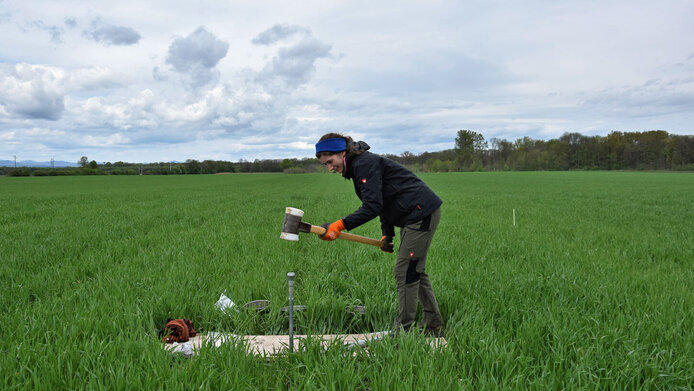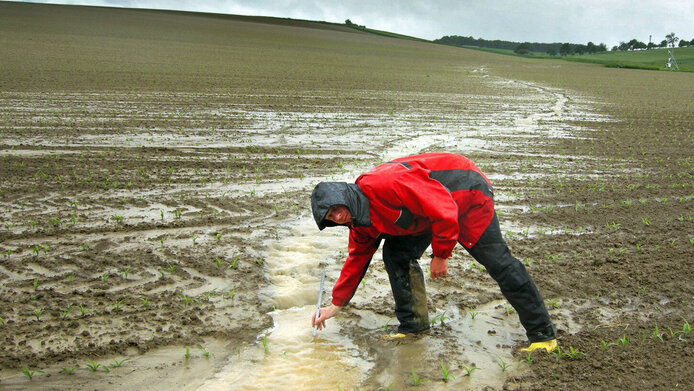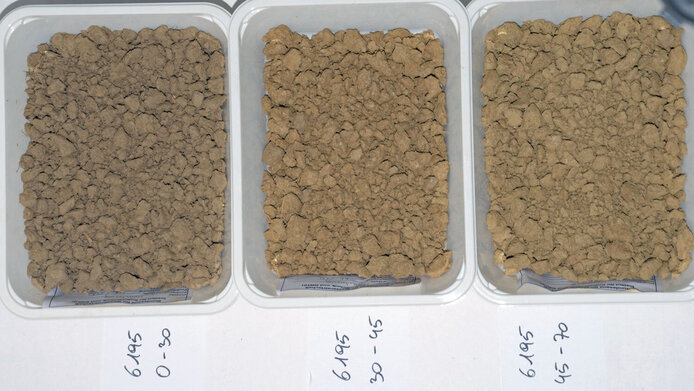Biodiversity as a barrier

This is a fact that many people are unaware of: resistance genes do not exclusively originate in hospitals, the veterinary sector and intensive animal husbandry, and spread from there. A huge pool of these genes is found in soil, air and water, causing problems for humans. “Some resistance genes that render the antibiotics fluoroquinolones, carbapenems, and colistin inactive, almost certainly originated from environmental pathogens. The question is not whether more resistance will transfer from environmental reservoirs to human pathogens. The question is only when,” says Markus Wögerbauer, a senior researcher in the Risk Assessment Department of the Austrian Agency for Health and Food Safety (AGES).
There are many pathways for antibiotics, antibiotic-resistant bacteria (ARB) or antibiotic resistance genes (ARGs) to spread across ecosystem boundaries. Wastewater is one of them, manure is another: resistant gut bacteria from pigs can get on to farmland soil and thus end up in the food and feed chain. “A major problem is that antibiotics produce high selection pressure among natural microbial populations. In this way, resistant bacteria proliferate and spread,” explains Markus Wögerbauer.
EU-wide cooperation
But how exactly do ARB and ARGs disseminate in the soil? And can an ecosystem that enjoys high microbial biodiversity curtail their spread? These are the questions investigated by research teams from seven European countries in the ANTIVERSA project, which is coordinated by limnologist Thomas Berendonk of the Dresden University of Technology. The Austrian institutions involved are the Institute of Water Quality and Resource Management at TU Wien and the AGES. The project is running in the context of Biodiversa+, a European co-funded partnership in support of biological diversity research. Alongside regional funding from the other participating countries, the project receives around EUR 250,000 in funding from the Austrian Science Fund FWF. TU Wien’s working group under the leadership of Julia Vierheilig is analyzing biofilms from streams, while Markus Wögerbauer and his team are focusing on soil.
Soil samples from fields, rivers and forests
The researchers took four types of soil samples, with and without human influence and with high and low levels of microbial biodiversity. Two samples came from an agroecosystem, more precisely from fields of the Hydrological Open Air Laboratory in Petzenkirchen. One sample was collected from a field fertilized with pig manure, the other from a field fertilized with compost. In addition, two soil samples were collected for purposes of comparison from a deciduous forest in the Danube Floodplains National Park and from a coniferous forest in the Gutenstein Alps.
In the laboratory, the researchers used a few grams from each of the samples to build hundreds of so-called microcosms, on to which they applied an enterococcus strain that carried an ARG on a plasmid, i.e. a small circular molecule of double-stranded DNA. The researchers then monitored the developments over a period of eight months. The TU Wien working group is conducting comparable analyses with biofilms from more or less biodiverse streams.
Biodiversity as a natural barrier
The researchers are investigating for how long the enterococci can remain in the microcosm, and what happens to the ARG, by determining the number of copies of the enterococci and the plasmid by means of qPCR methods. “The preliminary analysis of the data after five months of monitoring shows that high bacterial biodiversity reduces the spread of the resistance gene,” explains project leader Markus Wögerbauer.
The researchers want to keep an eye on another path that ARGs and ARB can take to disseminate through the soil. This pathway involves so-called circulating cell-free DNA. “This DNA degrades very rapidly at the beginning, but a small portion of just a few percent is bound in the soil and shows very poor degradation. Bacteria can reintegrate this bound DNA into their genome. This can also happen with antibiotic resistance genes,” explains the AGES researcher, but adds that such processes are extremely rare.
And what happens without the barrier of microbial biodiversity? In order to answer this question, the researchers applied enterococci to sterilized microcosms. “They feel very much at home on sterile soils, but on native soils one observes a marked decrease because the enterococci are not adapted to the ecosystem,” explains Wögerbauer. An experiment with E. coli also showed that the bacterium hardly survived in native soil. At present, Markus Wögerbauer and his team are also conducting research into how resistance spreads under conditions of drought stress and heat.
Healthy environment for healthy people
The central evaluation of the ANTIVERSA project is being conducted under the leadership of the TU Dresden. Together with the samples from researchers from the other countries participating in the project, a high diversity of samples, resistance genes and environmental influences has been pooled. In the current year, the final report of this wide-ranging research project will be published.
What conclusions can Markus Wögerbauer draw so far? “The healthier the ecosystem and the less outside stress it is exposed to, the better it is for us and the less hospitable it is for antibiotic-resistant bacteria,” concludes the expert. If ANTIVERSA's hypothesis is confirmed, the project will have demonstrated that in the absence of healthy, biodiverse ecosystems there can be no healthy humans.
Personal details
Markus Wögerbauer, a senior expert at the Risk Assessment Department of the Austrian Agency for Health and Food Safety (AGES), is a member of EFSA's GMO Expert Network and a member of the Working Party of Governmental Experts on Food Enzymes of DG Sante of the European Commission. His research focuses on the horizontal transfer of antibiotic resistance genes by means of free extracellular DNA and the risk assessment of antibiotic resistance genes in complex matrices, for example in agricultural soils. Markus Wögerbauer was the principal investigator of several national research projects on the transfer of antibiotic-resistant genes in natural habitats. He was a member of the management committees of several COST (European Cooperation in Science and Technology) Actions dealing with the dissemination of antibiotic resistance in wastewater and the environment.
Publications
Radu E., Woegerbauer M., Rab, G. Oismüller, M. Strauss, P. Hufnagl, P. et al.: Resilience of agricultural soils to antibiotic resistance genes introduced by agricultural management practices, in: Science of The Total Environment 756, 143699, 2021
Woegerbauer M., Bellanger X., and Merlin C.: Cell-Free DNA: An underestimated source of antibiotic resistance gene dissemination at the interface between human activities and downstream environments in the context of wastewater reuse, in: Frontiers in Microbiology 11(671), 2020
Woegerbauer M., Zeinzinger J., Gottsberger R.A., Pascher K., Hufnagl P., Indra A., et al: Antibiotic resistance marker genes as environmental pollutants in GMO-pristine agricultural soils in Austria, in: Environmental Pollution 206, 342-351, 2015







